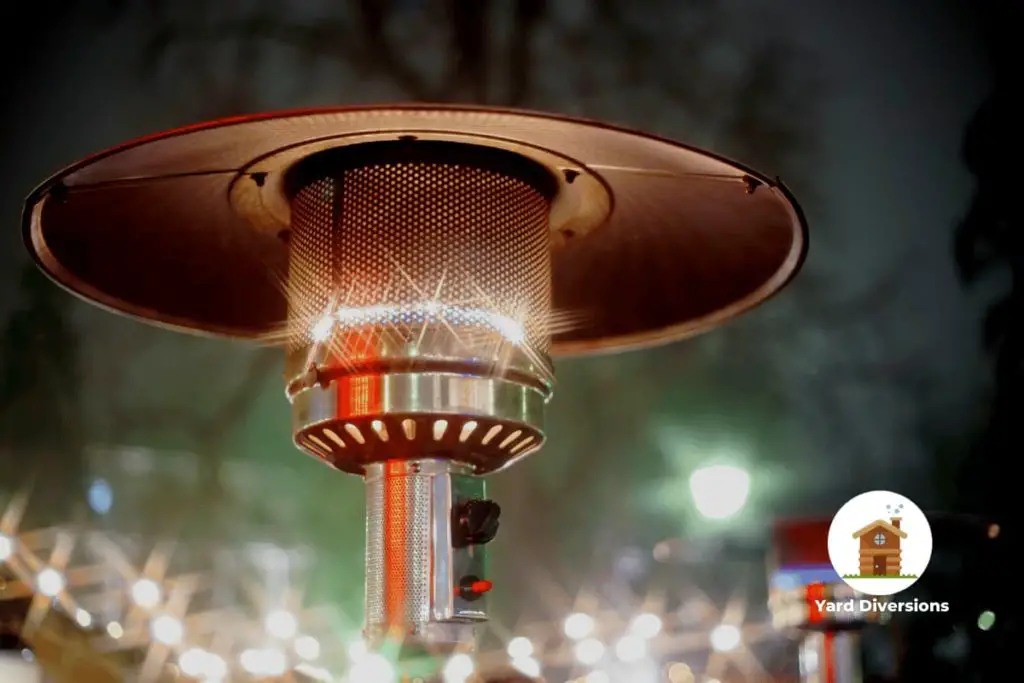You should be able to enjoy your patio throughout the year. Because of this, you might want to consider installing a heater. This will keep you warm during the winter months.
But what type of heater should you get?
First, it’s essential to determine the amount of heat the unit needs to produce. Patio owners also need to consider; the environmental conditions, the number of people using the patio, how they will use the space, and what safety features the heater provides.
You can choose from dozens of heaters, each with various pros and cons. This can make narrowing down the list difficult.
Please keep reading to learn more about the different types of patio heaters available and which suit your needs.

Calculating For The Right Size of Patio Heater
I wanted to help you to understand the basic question of, what size patio heater do I need. To calculate the amount of heat required, you will need to multiply the cubic feet of the patio by the desired temperature increase.
This will tell you the number of British Thermal Units or BTUs the heater will need to produce. The standard patio heater, like this SunJoy, will produce 40,000 BTUs.
The power of a patio heater will be measured in British Thermal Units (BTUs). The more BTUs produced, the hotter the heater will be.
A few factors will determine the size of the heater required. These are:
- Size of the patio. This is calculated by multiplying the space’s length, height, and width. This will be measured in cubic feet.
- Real temperature vs. the desired temperature. This factor is measured in degrees Fahrenheit. For example, imagine if the actual temperature is 10 degrees, but you want to get it to 50 degrees within the patio. That’s a difference of 40 degrees.
Once you know these measurements, you can calculate the number of BTUs you will need for your patio. All you need to do is multiply the cubic feet by the temperature difference.
This will give you a ballpark BTU number you can work off when purchasing a heater.
However, it’s also important to consider the unique nature of the space you are trying to heat. For example, if there is mesh on the sides of the patio, it will help seal off the space, keeping the heat inside.
It’s also a good idea to consider the number of guests using the area and where they will be sitting. This will help you find the ideal heater position, keeping everyone warm.
The most common patio heater will be sized at 40,000 BTUs. This will usually be enough to cover around 150 square feet of space.
What To Consider When Deciding What Heater To Get?
It’s important to consider the environmental conditions and how you intend to use them. This will affect the size and type of heater that best suits you. It’s also important to consider the safety features of the outdoor heater.
While knowing the size of the heater required is important, there are a few other factors you will need to consider.
First, you must consider your environmental conditions and how often you will use the heater.
If you live in a warmer climate, you might only need to use the heater for a few months of the year. In this case, it might not be worth splurging on a powerful device.
It’s also a good idea to consider how you intend to use the heater. Sometimes, you might only want to heat one particular area, like the space around a table.
At other times, you will have a larger entertaining area, requiring a more powerful heater.
It’s always a good idea to consider the safety features, especially if you live in a windy area. Here are some common elements that you should be looking for:
- Firm base. You don’t want to risk the heater being blown over by a strong wind.
- Auto-shut off. This monitors the temperature, turning the heater off if the room gets too hot.
- Thermocouple. This feature monitors changes in the temperature of the heater. If it stops burning, it cuts out the gas.
- Positioning the heater correctly. Having a bit of common sense when using the heater is also important. Ensure you are positioning it carefully, avoiding any curtains or flammable objects. It should be at least three feet from anything that can be potentially combustible. This can include things like pot plants. It’s also a good idea to read the manufacturer’s instructions for any other safety information you might have missed.

What Type of Patio Heaters Are Available?
The most common types of patio heaters are; freestanding, tabletop, mounted and hanging.
Additionally, there are multiple types of fuel sources for patio heaters. These different options are propane, natural gas, electric, and wood.
There are many types of types that you can purchase. Some of the most common patio heater options are:
- Freestanding. These are typically powered by propane gas. They are a little bulkier than other heaters, but they will produce a lot of heat.
- Tabletop. These heaters are best suited to dining. They are more compact models that will sit on a table. But they will have a lower heat output than other types of heaters.
- Mounted. If you want your heater to be kept out of the way, you might want to consider a wall-mounted option. This will be attached to the roof of your patio. These can be either electric or propane-powered.
- Hanging. As the name suggests, this heater will be connected to the ceiling and hang over the table. This provides an even distribution of heat and won’t take up any space on the floor or wall.
Just like there are multiple heater options to choose from, there are multiple fuel sources that you can choose from. These include:
- Propane. These are the easiest to use, all you need to do is get them into the right position, and you’ll be able to start heating your home. However, they will require a tank. A 20-pound tank will last for around 10 hours.
- Electric. This will be the most difficult to install initially, as you will need a professional electrician. Plus, it will be difficult to re-position and can take a little longer to warm up than a propane heater. However, the electricity costs involved will be low.
- Natural gas. If you already have natural gas in your home, these heaters can be connected to that line. This ensures you don’t have to worry about running out of gas. But they will need to be professionally installed.
- Wood. Some people prefer to use wood heaters. These will be the most aesthetically pleasing, creating a flickering flame. But the heat won’t be as consistent as some of the other models.
Do I Need to Consider the Size and Design of My Patio Heater When Choosing a Cover for Protection?
When considering a patio heater protection cover needed, it is important to take into account the size and design of your heater. Make sure the cover fits properly and provides adequate protection from the elements. Look for a cover with a design that complements your outdoor space.
Final Thoughts
Finding the right patio heater can be tricky, but knowing how much heat it has to provide for the space and the type of heater to fit your needs can help you narrow down the choices and find the right one.
Check out our buyer’s guide for more details on choosing the right patio heater!

